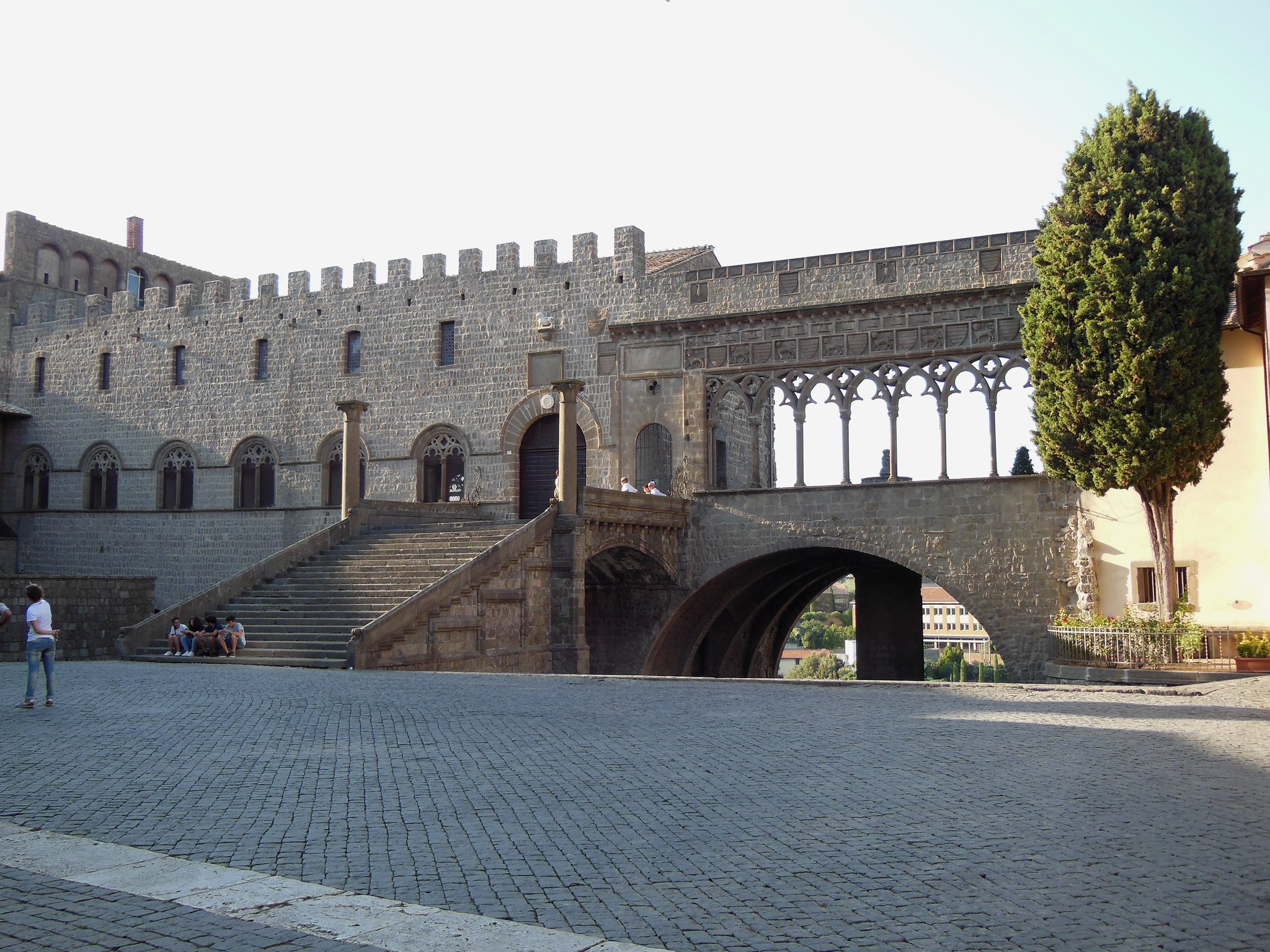
VITERBO.
Viterbo has been called the city of the Popes for centuries, because the papal seat was precisely moved to this city, which still bears the signs of that period, although it has even more ancient origins.
A capital of ancient Etruscan origin and great historical traditions, it preserves one of the most important monumental arrangements in Latium.
The Via Francigena, which almost entirely retraces the stretch of the Cassia, allowed pilgrims from beyond the Alps to reach the papal seat in Rome. becomes a busy stop for these faithful who stay and refresh here in anticipation of the final stretch to the Eternal City.
The construction of the Via Cassia was a reason for development even before the pilgrimages, in fact some wealthy Roman families, due to the presence of the baths, built rich dwellings there, increasing trade, agriculture and animal husbandry.
In 1080 the church of Santa Maria Nuova was built and attached to it a hospital and shelter for pilgrims. The city then began a new flourishing period that led to the establishment of new neighborhoods and, in 1095, the first construction of the city wall. In 1145 Pope Eugene III elected the city as the seat of his papacy. While this creates significant economic and cultural enrichment for the city, it also develops
of hostilities with Rome that would result in several battles.
The 13th century represents the heyday of the city of Viterbo. Pope Alexander IV in May 1257, to escape from Rome, moved the papal court to Viterbo. With the coming of the popes, a new cycle opened for the city. New churches such as Santa Maria in Gradi and the Church of the Holy Trinity were built, as well as public structures such as the Palazzo dei Consoli and the Palazzo del Capitano del Popolo. He also began the construction of one of the most important works for Viterbo: the Papal Palace. After Alexander IV came Urban IV, Clement IV and Gregory X.
The latter’s election will go down in history. The sede vacante before his pontificate lasted a full 33 months, which ended when the people of Viterbo, tired of the lengthy nature of this election, intervened by locking the cardinals in the papal palace by uncovering the roof and blocking the supply of provisions to them. On Feb. 22, 1281, Pope Martin IV was elected, leaving the city and moving to Orvieto; without popes, the city slowly declined.
With the Renaissance, Viterbo increased its beauty. New gates (Faul), fountains (Fountain of the Rock), churches (Basilica of Santa Maria della Quercia) and residences (Villa Lante in Bagnaia) are built. In the 600s, San Martino al cimino also came to light. The village, commissioned by Donna Olimpia Maidalchini, is a perfect example of Baroque architecture.
Of the many wonders you can admire as you stroll along the streets of the San Pellegrino district, some, in a special way, will catch your attention. The reference is to the characteristic medieval bridge houses: stone-built and well-preserved, a type of dwelling that joins two buildings, separated from the street, at the first or second floor level, creating striking covered passageways. have original structures, making it the unique medieval quarter in Italy.
Not surprisingly, it was chosen by director Zeffirelli to set his unforgettable film Romeo and Juliet. But not only our filmmakers have chosen the wonders of this untouched historic center, even George Clooney recently set part of a TV series there.
The city also has a very interesting history from a geological point of view. Few people know that in fact underneath the center are numerous underground tunnels dug into the tuff, connecting most of the buildings in the historic center, creating a network of walkways that can be visited with a guided tour.
Albornz Fortress, p.zza della Rocca, houses the National Archaeological Museum Trinity Church, p.zza della Trinità, a building with a distinctive Baroque facade and large dome. Inside preserves frescoes, paintings and canvases from various periods from 1300 to 1800.
Shrine of St. Rose, v. S. Rose, inside a valuable urn is kept the body of St. Rose, remembered by all for spreading the faith among the people of Viterbo during the revolt against Frederick II. In addition to seeing the body, it is possible, by addressing the convent, to visit St. Rose’s house.
Every year on Sept. 3 it is commemorated with the transportation of the car of St. Rosa, a monument about 30 mt high, weighing 5 tons carried on the shoulders of 100 men (porters Church of St. Sixtus, one of the mostimportant monuments of the city, the particularity of the Lombard bell tower manifests the artistic influence from a long period of domination.
Fontana Grande, p.zza Fontana Grande. One of the most beautiful and impressive in the city was erected in the 13th cent. Palazzo dei Priori p.zza del Plebiscito. Notable is the arcade that runs along the entire facade
With vaults and capitals. Erected in the 13th century, it underwent profound changes in the facade,
completely redone In the same square stands the Clock Tower, a bulwark of the city adjacent to the Prefecture Palace, which at one corner, supported by two granite columns, houses the Lion of Viterbo, the symbol of the city.
Chigi Palace (Chigi Street). The splendid façade and majestic tower make the building a remarkable renaissance testimony.
Palazzo Farnese: via S. Lorenzo Elegant 15th-century building.
Events and demonstrations
March Antiques and Annunziata Fair national antiques market exhibition.
San Pellegrino in Bloom last weekend of April and first weekend of May, where the beautiful center is invaded with flowers displayed by the most famous Italian nurseries.
Tuscia Film Festival review dedicated to Italian cinema June July.
Caffeina Festival literary events featuring writers and journalists. August.
Patronal Feast of Santa Rosa September 2/3/4 with the famous transportation of the Macchina di Santarosa.
Caffeina Christmas Village December became one of the most beautiful and famous Christmas events.


